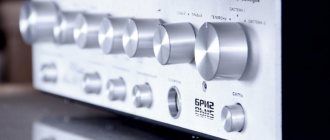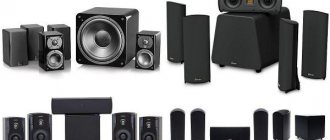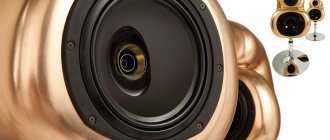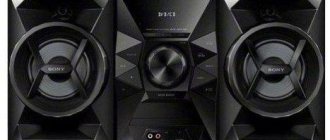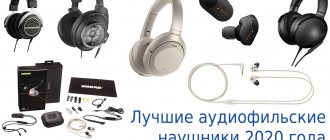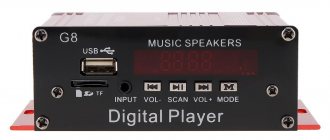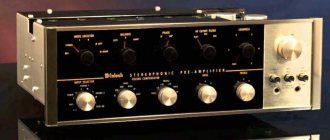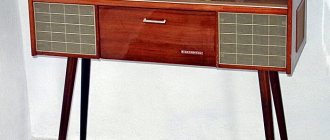Among radio amateurs, Soviet amplifiers are still popular to this day. Radio transmitting devices, acoustic systems for home theaters, electric guitars and other musical instruments are built on their basis. One big disadvantage for lamp-based units is that they require 220 Volt AC power, since the power transformer can only work with it. Therefore, it is problematic to use such amplifiers in “field” conditions. And the dimensions and weight of these devices are very impressive. What kind of low-frequency amplifiers were produced by Soviet industry?
"Electronics 50U-017S"
The appearance of this Soviet sound amplifier is very attractive - the silver body harmonizes perfectly with the chrome-plated control knobs. The power button is located on the left side of the front panel in the upper corner.
Below, in order, is the location of the controls and displays:
- A luminescent indicator, almost eternal, can last for a couple of hundred years for sure. You just need to take proper care.
- Switching organs for two pairs of acoustic systems.
- Bass and treble tone controls. By the way, the peculiarity of this amplifier is the presence of filters that cut off the high-frequency part and leave only the low part.
- Loudness control buttons.
- Switching between “Stereo” and “Mono” modes.
- On the right side are the volume and balance controls.
There is still an inconvenience - they use plugs with 5 pins, which you won’t find today. But if you wish, you can install adapters or completely get rid of the old connectors and install new RCA connectors in their place. If you do not modify the amplifier circuit, then in terms of playback quality it is much inferior to the ULF "Brig". But it beats Radiotekhnika U-101 or Vega in all respects.
"Radio Engineering U-7111"
This is one of the best Soviet amplifiers, at one time it was the most “budget” option. But when compared with modern Chinese-made amplifiers, Radiotekhnika U-7111 is significantly ahead of them. The ULF kit included a tuner (radio signal receiver) and a player.
Externally, a very attractive amplifier, there is an equalizer with five-band adjustment. The front panel contains the following controls:
- Button for turning on the “Mono” mode.
- Button to turn on the high pass filter.
- Loudness compensation.
- Tone adjustment for high and low frequencies.
- Volume adjustment.
On the rear panel there are connectors for connecting audio sources - there are four in total. A maximum of two speaker systems are connected to the ULF output. There is also a ground terminal, fuse and sockets. In general, music lovers rate the sound as good, but out of 5 points, the maximum is 4 plus.
HI-FI in Russian
This article is about how to assemble an amplifier for 3,000 rubles that combines the best qualities of these two beauties in the photo below...
Of course, you recognized them... More recently, I had two of the most prominent representatives of Soviet amplifier construction - Odyssey U-010 stereo Hi-Fi from 1987 and Brig-001 from 1983.
And two more less bright, but more common - Amfiton 202 and Electronics 50U-017, which are also presented in the pictures below.
Plus, there were Odyssey 001, Rostov MK-105S, TDA 2004, TDA2030A, TDA2050, TDA7294, all included as standard.
Now I no longer have any of this... But there is this article in which I will tell you why. First things first, the most interesting stuff is usually at the end.
There is a lot of discussion on the Internet about all of the above amplifiers, about who has what kind of sound, who repaired, modified how, who, how they threw out the filling and installed TDA, and who, in general, does not recognize anything other than Japanese vintage, abundantly pouring nonsense statements on Soviet developments , again, we can agree on many things, but not on some things, everyone has different hearing, different speakers, different sound sources, and besides, on the forums they write as engineers - electronics engineers who know a lot about not only sound, but also the circuitry itself , as well as simple radio amateurs like me, so don’t judge strictly, I’ll try to share my thoughts on what’s what as objectively as possible, but not abstrusely.
Over the course of a year in my city, I bought more or less working Soviet amplifiers, restored them and listened to them, hoping to find one that would satisfy me with sound quality, assembly, design, and I simply liked it, and I describe the results of my searches in this article.
I warn you right away that in all Soviet-made copies I changed electrolytes, EVERYTHING, even non-polars and nutrition, of course the sound immediately improved, noise disappeared, deep bass appeared, etc. I will not give detailed technical characteristics of these devices, hoping that people reading this article probably know them, but I just want to share my subjective listening impressions.
So... Odyssey 001 is old, produced in ’75, but this grandfather knocks 30GD out of the basket like it’s not 30 Watts / 4 Ohms according to the passport, but all 100, seriously, I was stunned by what he does with the low-frequency driver, and this is probably The only thing I liked about him, but no, there is something else - he is 37 years old and he works!!! The distortion factor is 1% and it is noticeable, although the sound is not soapy - there are so many highs that you can pull out the high-frequency speakers with such an amplifier, and the bass is quite unique due to germanium transistors. Paired with the S30B, it definitely plays better than budget Svens, and besides, it is truly retro in wood and with good assembly. I liked it.
Rostov MK-105 S is a tape recorder, the power for the S90 is exactly what it came with, the sound is very good, and with these speakers, soft bass, good design, beautiful dial indicators, however, even when replacing all the capacitors Hissing remains, this is due to the long path of the audio signal to the power amplifier (through the input amplifier, tone control, playback amplifier), moreover, the signal circuits are not shielded, but if you turn up the volume this drawback is no longer audible. I liked it.
Amphiton 50U-202 - probably like any amphiton of a similar model range (25U, 35U) is not suitable for high-quality sound reproduction, no matter what you do with it, there are no highs, or if you turn it up, they are distorted, instead of bass there is a hum, and if you turn on loudness compensation, then it is active subwoofer filter is ready)). The device is distinguished by its simplicity and reliability, even excessive, probably many users of this amplifier have ever had the thought of replacing one resistor in the protection in order to reduce sensitivity. It is of interest only as a case with good radiators for installing TDAs, for example. Didn't like it.
Electronics 50U-017 . Electronics, as the flagship of Soviet electronics, loved to make watches and calculators, so they would continue to do so... I have never seen such sophisticated circuitry, it feels like they crammed everything they could into it, as if they hadn’t installed a processor yet)), but somehow the sound is positive this had no effect, noisy, incorrect due to the electronic switch and the same unshielded long signal loops as in Rostov 105, the tone controls are too sharp, with increasing power the distortion increases too much, but the loudness compensation is unusual, as if pressing, deep, and a nice indicator, however The main thing is the sound, but it’s not very good. Didn't like it.
TDA 2004 – if only it was...
TDA2030A - well, so-so, but you can fry something or someone on its radiator)).
TDA2050 is already something, I overclocked it to 50 Watts/4 Ohms, it held up, the sound is pretty good if you don’t listen too closely, because... The detailing is typical microcircuit, i.e. soap, but I liked its soft bass tonality and reliability. In my opinion, the best choice for listening to music without bothering you at no extra cost. There was an idea to make active S30s with it, I think they would work well together. I liked it.
TDA7294 – I won’t write much, everyone knows everything, the chip is very popular. I liked it because of the price/quality ratio, probably only the LM3886 is better in sound, but at least in our country it is twice as expensive. The detail is higher than that of the TDA2050 and in comparison with it the sound is colder and sharper, possibly due to more pronounced high frequencies. Although, if you don’t find fault, the TDA7294 is quite suitable for the S90 as an amplifier for listening to pop music at an RMS power of up to 50 Watts, higher than that it’s no longer hi-fi... Until I bought the Odyssey-010 it seemed okay, now I can’t perceive it well.
Before moving on to the best ones, a few words about how I listened. For listening I used an HD Audio sound card, bitrate from 320 and music of different styles, here are just some compositions: Dj Matisse & Lounge Paradise - This Love (Maroon 5 Cover); DJ Shah feat. Nadja Nooijen – Over and Over (Original Vesrion); Lesopoval – Ya kuplu tebe dom; Wicked DJs - Disco Rocker (Picker Remix); Stas Mihaylov – Koroleva; Tritonal Ft. Cristina Soto - Forgive Me, Forget You (Triple Mash Intro); Eva Polna – Luby menya po francuzski (Fonzarelli Chill Out Acoustic Mix); Dire Straits - Money For Nothing (Album Version).
The speakers are my favorite S90, which I naturally modified; the essence of the modification should probably be entered as a standard in the GOST register, but I will once again list the main methods of treatment:
- Coating seams with sealant
- Treatment of the internal surface with rubber-bitumen mastic
- Pasting the inner surface with synthetic padding (ideally, of course, with felt, but I just couldn’t find it anywhere in the city, and I don’t want to cut felt boots, and I can’t get by with just one pair)
- Damping the mid-frequency speaker or replacing it with 6gdsh - by the way, I didn’t find that either, so I sealed the basket windows with 15gdsh foam
- Replaced the wires with thicker ones
- I painted the grilles with glossy black enamel and covered them with wood-effect self-adhesive
- I laid a couple of bags of cotton wool
- I want to put them on tenons, but I don’t have time to sharpen everything, and I think this will be the final point of improvement, I can’t get more out of them.
And now they really sound!!! And now about the best.
Odyssey U-010 stereo Hi-Fi – brutal, quite a solid thing, 16 kilograms of non-ferrous metal. In addition to its attractive appearance, it has two advantages - power and bass. If you measure root mean square power according to the RMS standard, then at 4 Ohms I squeezed out 183 Watts, at 8 Ohms 120 Watts, beast)). Probably everyone has had this feeling when you are driving our domestic car and accelerate to a hundred and then slow down, because... it seems like it’s about to fall apart, and then you get into a foreign car, you give it a little gas, and it’s already 60, a little more 100, but everything is comfortable and the speed is not noticeable, about the same here, I crank it up to full, so that the sound wave moves in the bass T-shirt, but the sound is not distorted, it is almost the same as when the volume knob is on two, although the power for the speakers is already dangerous, the music does not turn into a coherent set of sounds, well, except at the very maximum, I really like it.
By the way, by the way, you can also say about it “a bucket with nuts.” The parts are random, the wires of the power supply and output transistors are thin, there is no shielding, the soldering and PCB, to put it mildly, are not the best, while I was resoldering the capacitors, several tracks came off, I had to lay the wires.
A preamplifier for a device of this level is terrible, when all the knobs are at zero we already hear a slightly different sound and only by connecting the signal directly to the PA plug can we talk about quality, although this preamplifier is interesting with such a unique thing as “frequency response balance”, discrete controls and many functional buttons .
The power supply is great! Although the transformer is humming, I filled it with paraffin - it didn’t help, but it’s so powerful and tightly assembled. A distinctive feature of this amplifier is the presence of a voltage stabilizer, in general a unique thing in Soviet amplifiers, as well as the balance of the frequency response. The stabilizer allows you to maintain a constant voltage level on the power amplifier +/- 37 Volts even at high volumes. The voltage drop, according to my measurements, was only 0.6 Volts! This largely explains the good sound quality at high powers.
The protection allows you to work not only with an 8-ohm load, but with a 4-ohm load, however, at a volume of more than half you need to be careful, when the output is shorted, the protection does not help, AND YOU DO NOT NEED TO CHECK FOR ME!, although on the other side they fly out for some reason - then transistors like KT502 are in the stabilizer, and a couple of KT818/819 outputs in the PA remain unbroken, strange.
Despite the shortcomings of the performance, of course, it is worth noting the sound, it is good, or rather the bass - it is clear, even a little rough, but quite deep. I love progressive house, tech, electro - it’s great for such styles, which can’t be said about pop and classical, it doesn’t have enough highs by default (the initial problem is in the tone block), you have to turn them all the way up by hand, then the cymbals can be heard well, the mids so himself and in this he will clearly lose to the next one.
Brig 001 - a copy of 1983, the second version of the circuit design with one op-amp in the power amplifier. I read somewhere that the first copies were installed on personal orders in the offices of officials of the CPSU Central Committee, who loved good sound and who then listened exclusively to Japanese Marants and Technixes, which were naturally not available to ordinary citizens. However, the brig was not available to everyone, since its price at that time was about 600 rubles, while the same Odyssey -010 later cost 350.
Of course, the brig is the best, the best of the Soviet ones of that time, there is a lot of controversy and discussion around it, but few improvements, this means that for some it is already not bad, but not for me. It is undoubtedly very reliable and stable, and also well assembled, I had a copy with military acceptance parts. In general, it is not particularly repairable due to the fact that all the main components are connected not using plugs and plugs, but with wires and soldering, however, unscrewing any board is not particularly difficult, but to remove it you will have to solder. The quality of PCB and soldering is excellent. The number of electrolytic capacitors is probably even smaller than in all amplifiers described earlier.
About sound. This is an amplifier for chanson. And restaurant music, which I also love, it’s a great pleasure to listen to it, in general, everything with vocals and live instruments, classics, jazz. Sparkling highs, good mids, vocals and good lows, judging from this sequence it is easy to conclude that this is the opposite of Odyssey 010, plus I would add to this statement that listening to the brig through a plug, bypassing the preamplifier, I would not say that it impressed me , rather, on the contrary, the beauty of sound emanating from the brig is largely due to its timbre block.
Many people like its soft bass, personally I don’t, because when listening to electronic or heavier music at rated power, all that soft bass becomes mush.
It turns out that each amplifier is good in its own way, there is no universal one...
Of course, after reviewing all the options, only the last two remain, but they are not alike, heaven and earth, double bass or cymbals, bottom or top, choose who you like. We are all different and the technology is different, some have hearing, some don’t, some can listen to a Chinese radio at the dacha without worrying, while others are not satisfied with a home hi-fi system for a round sum and want something more , people are starting to switch to tubes...or spend a lot of money on branded audio equipment. And probably for the average listener, happiness lies in the balance of price and quality, so as for the sound of Soviet amplifiers, it is not bad, after replacing the capacitors, correct ground wiring and shielding, adjusting the quiescent current, replacing some parts with imported ones, increasing the power of the supply transformers or replacing them toroidal...etc., so many things!
I want the bass of an odyssey and the vocals of a brig, combining the best qualities in one device. Do you really need to take and solder one to the other? What should a person do who wants to immerse himself in the world of good sound without much hassle and expense?
My answer is to accumulate the same collection, bring them to mind, listen to them again, make sure that there are no ideal Soviet amplifiers, just as there are no ideal women, be disappointed and sell everything!
And assemble it yourself!
And in a hardware store you always pass with a smile people who choose a beautiful Chinese stupid box with an incredible number of tulips on the back panel and a price equal to their salary... when, right at home, there is an amplifier that is awesome in sound, simplicity and cost, capable of both performance and sound make the Chinese receiver smoke! I offer an amplifier that has both high and low, in which everyone will definitely find a part of the brig and the odyssey for themselves and hear for themselves what they want, as I did!
What kind of amplifier is this?
Is this Radiotekhnika U-101?!
In general, Radio Engineering was probably simply created so that one day it would be “raped”... it is beautiful, even now its ergonomics and design excite the inquisitive minds of radio amateurs whose hands are itching and it only has 20 watts - this is too little to resist. We will take it as a very convenient platform for implementing our own ideas in the field of good sound for the home.
Next we will describe the assembly of a COMPLETE amplifier, which includes a preamplifier, a power amplifier, an indicator, protection, and two power supplies. All this is in the Radio Engineering building.
Scheme:
From many different schemes, I chose those that at the moment, in my personal opinion, are optimal in terms of price/quality ratio, I will say right away that I did not make any changes other than those described in the original schemes, everything was done as it is. I won’t talk for a long time about the blocks themselves, I’m not a radio engineer to explain where things are happening, I’m an ordinary radio amateur, so read the detailed information at the links provided. I am in no way copying circuits, nor am I encroaching on the copyrights of people - radio engineers who spent time and money creating these circuits. This is a collection, a collection that is quite enough to satisfy the average listener who does not want to pay crazy money for who knows what. This amp really plays!
So, let's begin.
When I finally got under its cover... I was horrified, the wires from the trance were charred, the parts in the power amplifier were soldered in an unclear way, some were soldered in with only one leg, when turned on, the rectifier diodes got very hot and smelled of smoked resistors)). The indicator did not light up. But outwardly it was well preserved. A wonderful example - just what I wanted for a remodel.
Complete dismantling began, as a result of which I left the transformer, tone control, indicator, and input switch.
Photo of the insides (this is not my copy, everything is still good here).
Switch
We need it so that there is no hole on the back panel and so that there is a socket for entry. The socket above which “record” is written is free and there are no tracks on the board going to it; we solder a shielded acoustic wire leading to the preamplifier to this socket. This will be the line input. We immediately connect the mass with wiring to the amplifier housing; for this purpose, there are special petals on the frame; if this is not done, there will be noise.
Also, the switch board can serve as a platform for mounting the protection board; to do this, we take out the phono preamplifier box, thereby freeing up space and install the speaker shutdown relay, which is part of the protection circuit, on liquid nails, and mount the board itself next to it.
For example, I managed to clamp the heatsink of the output transistor of the protection circuit between the blades of the fuse socket.
Indicator
We change electrolytic capacitors. Let's tidy up the wires.
Because I pulled everything out and had to figure out which wire goes where.
If you look at the XP7 socket, the one that is inserted onto the display board, then contacts 10,11,12 go to the filament and are soldered to the corresponding terminals on the transformer.
Contacts 5-plus power, 6-minus power, 4-common are connected to the preamplifier power supply before the stabilizers, it will be shown below how.
Pins 2 and 3 are connected to the outputs of the right and left channel power amplifiers.
Nutrition
To power the power amplifier, I took a toroidal transformer with two identical secondary windings of 20 Volts each with a power of about 100 Watts and bolted it to a metal substrate at the bottom of the amplifier housing, having previously drilled a hole of the required diameter in it. Next to this trance we place the power amplifier rectifier. As a diode bridge, we take an imported KVRS 5010. We assemble a block of 6 capacitors of 4700 μF x 50V, 3 per arm, and shunt it with two 1 μF film capacitors. The scheme is standard and does not need explanation.
The preamplifier, indicator, protection and switching will work from the native trance. On the original transformer, pin 6 is the middle point, and a voltage of 16.3 V comes out from pins 5 and 5; we connect these contacts with wires to the stabilizer circuit (pins 5-6-5). And they also provide power for the indicator.
To power the protection circuit we make a separate rectifier, because when connected to an existing preamplifier power supply, noise and low-frequency hum arise, which I could not overcome even with a 10,000 uF capacitor. But here another problem arose - the protection circuit works with a voltage of about 24 Volts, which means that about 16 Volts must be removed from the transformer before the rectifier, however, when measuring the voltages of the remaining windings of the original transformer, the minimum that I found was 37 Volts between terminals 4 and 4', I had to and use them, because a third transformer would be too much. After the rectifier, the voltage was reduced by a chain of a 5-watt 1-kohm resistor and 3 D814 zener diodes connected in series. Of course, everything could have been done more professionally and a suitable stabilizer could have been selected, but everything works that way.
Protection
This protection circuit is quite popular, so I find it difficult to indicate the original source; a similar circuit is in the brig001 amplifier from the very first edition. One thing I can say is that before this I assembled two more similar circuits, but designed for bipolar power supply and was dissatisfied with their work, the problem was that no matter how I configured and selected the ratings of the parts, the voltage at the contacts of the relay coil did not drop to that level in which the contacts connected to the speaker would open, but here everything is simple and reliable. Turn-on delay is about 2 seconds. During the preliminary check, I connected two AA batteries between the common wire and resistor R1, thereby making sure that even at three volts of DC voltage the circuit works, clicks the relay and turns off the acoustics. Switch S1 is placed on the front panel (mine is to the right of the indicator), it can also control turning off the speakers. Any transistor VT3 that is more powerful from the KT 815, KT 940 series, etc. It gets hot, we put it on the radiator. The board is not designed for laser ironing technology.
Preamplifier
I wanted to keep my original one, I have it with a version on three microcircuits, but the SP-3 resistor with loudness wore out all my nerves with uneven regulation and rustling, although after filling it with machine oil the situation improved, you need to understand that this is still an emergency measure, but to find one a new one is probably no longer possible even at the manufacturing plant itself, as well as the plant itself...
In addition, the level of noise and distortion of the native tone block was high; I connected it, as many advise, bypassing the first microcircuit and still threw it away. Although as for the sound, I liked this pred, the bass is deep, there are highs and in general it sounds somehow pleasant. However, we are assembling real Hi-Fi and therefore we don’t need any artificially created amenities; we need a tone block that, by default, does not introduce audible changes in the sound.
I once assembled it on a TDA1524 - horror, the distortion coefficient is about 0.3%, that’s a lot, no matter how I didn’t center the resistors or select the capacitors - the microcircuit still makes changes to the sound, it will only work as an active filter for the subwoofer.
I read about Solntsev's pred, which, in addition to good characteristics, also has good reviews, but did not collect it, because... there is a need to use a resistor with loudness compensation, which cannot be found in a normal state, and besides, the preamplifier is built on the same Soviet element base, from which I have already moved away to imports.
I assembled it on LM1036 - all the same problems as with TDA, but the distortion coefficient, according to some sources, is about 0.05%, this is already better, and it sounds much better, although cheaper than TDA and still not the same, not Hi- Fi.
And then I assembled a preamplifier using three NE5532 operational amplifiers - class, when the knobs are in the center, it’s as if there was no tone block at all - this is what I wanted and was looking for! For some reason I didn’t find a mode of linearity of the frequency response, harmonic coefficient for these datasheets in the datasheet, but there is data that is 0.007%. It’s bad that there is no loudness compensation and its implementation is possible, again, with a special resistor. This is exactly the tone block that will go into my complete amplifier. This diagram was taken from a foreign site at this link.
I don't think there's much to explain here
I couldn’t find the board online, so I had to develop it myself. The board was not created for laser-iron technology; I make boards the old fashioned way with a marker and etching in ferric chloride.
Amplifier
And here it is, the hero of the occasion, who captivated me with its sound and cost, the STOUNCOLD
I won’t write anything here; probably no one can talk about it better than its creator, whose article can be read here
On my own behalf, I’ll just add that at a voltage of +/- 27 Volts, the rms power when supplying a sine wave with a frequency of 1 kHz at a 4-ohm load was 104 Watts and also - I haven’t heard anything better yet...
About the assembly
In the Radiotekhnika amplifier, the tone block resistors were soldered into the preamplifier board itself and fastened with nuts to the bar, which in turn was connected to the housing. To install imported resistors into the same holes in this strip, you need to drill holes for the resistor protrusion with a diameter of 3 mm as in the pictures. This will provide a guarantee against rotation, besides, this protrusion is formally the middle of the resistor horseshoe, so it is necessary to drill holes as evenly as possible horizontally. We secure the resistors with nuts on the reverse side.
Disabling the tone block in my preamplifier is done using a relay, which I powered in the same place as the protection board; the tone on/off button is located on the front panel (on my left).
After removing the main internals, I also removed the “input copy” and headphone jacks, leaving holes on the front panel, which is not very nice. In this case, I used Soviet non-polar capacitors of the K50-6 type, wrapped with adhesive tape in one layer, which fit very well into these holes, now it looks more like buttons.
The most difficult part of mounting power amplifiers was installing them on radiators. It was necessary, without bending the legs of the transistors too much, to attach them to the radiator, naturally through a layer of thermal paste and mica or thermal rubber, as in my case. To do this, drill holes between the ribs in pre-marked places. Because I didn’t hit it exactly in the middle - I had to grind down the bolt heads perpendicular to the groove for the screwdriver, which in the end was also the best option, because resting against the rib when tightening the nut from the reverse side, the bolt does not turn.
Do not connect the common wire of the power amplifier power supply to the housing frame directly as a preamplifier! A low-frequency hum appears, which is precisely why the problem with the power supply of the protection remained unresolved, because When connecting the common protection wire to the common wire of the power amplifier, a slight hum also appears. Therefore, the protection circuit currently functions only as a turn-on delay circuit; in this mode there is no unnecessary noise.
As a coil in a power amplifier, a coil from Holton, Radiotekhnika’s own powerhouse, was perfect. When assembling, do not skimp on insulating tape, flux and solder.
Economy
- Dead radio equipment 150 RUR
- Transformer 2x18 Volt for PA, which is especially nice, produced by our TopTransform plant in Rybinsk 700 RUR
- Diode bridge and power amplifier capacitors 410 r
- Preamplifier for NE5532 530 RUR
- Protection board and relay 130 RUR
- UM stonecold 300 r one channel, i.e. stereo 600 RUR
- Manufacturing of circuit boards - textolite, solder, flux, ferric chloride, drills, felt-tip pens 165 RUR
- Buttons, wires, plugs, capacitors for indicators, etc. 125 RUR
It turns out 2810 rub.
Impression
The first thing that catches your ears is the detail of the sound! A good stereo panorama, but as described by the creator of the stonecold, not into space, but for the listener. Many people complain about the S90 because of its poor midrange, but when playing with this amplifier, this drawback is compensated by a more pronounced midrange and excellent vocal reproduction; the highs are also quite sufficient. As for the bass, everything is fine here too, it is clear, but not harsh.
Here you have Odysseus and Brig, all in Radio Engineering. The radiators of the pre-output transistors are warm, the radiators of the output transistors are cold, that’s how it should be!
The power, as I already said, is 100 watts at 4 ohms, there is no way to measure the distortion coefficient, but I think it is small and if compared with the Soviet ones, then 0.01% or even less, at least at high power it plays even cleaner than the Odyssey 010.
I am very pleased, firstly with the sound, secondly with what I did myself, and thirdly with the price-quality ratio.
To finalize everything written above, I will say that with great enthusiasm throughout the year I have been buying Soviet equipment in search of something that will stand on my windowsill and delight me with its sound, but time does not stand still and if once these things cost decent prices by the standards of the money and were quite satisfied with their quality, now we must admit that our civilian electronics remained somewhere there in 91 and it looks like it’s not sad that it remained there forever... We must pay tribute to all Soviet things, we still use and steal them! Now, when you go to a radio parts store, you can buy a KT3102 from 1987 (there is simply no newer one) or an analogue of the BC546, which is newer, cheaper and of better quality, naturally I will choose the second. And I’ll be honest, I didn’t want to sell the brig, I liked it, it had military-grade details, the build quality and sound were quite high, but when I assembled the stonecold I was finally convinced that the obsolescence of the equipment was not just empty words. I listen to it with the preamp turned off, I don’t need to turn up the bass until the glass rattles, everything is enough for me as is. And what is most important is the presence of a strange feeling that any song possibly sounds exactly the way it should sound, perhaps this is High Fidelity!
List of sources: https://sound.westhost.com/project97.htm https://redwi.ru/zvukotehnika/usilitel_stounkold.html
printed circuit boards in Sprint-Layout format
Author: Chizhov M., Rybinsk 2012
List of radioelements
| Designation | Type | Denomination | Quantity | Note | Shop | My notepad |
| Preamplifier | ||||||
| OP1-OP3 | Operational amplifier | NE5532 | 3 | Search in the Otron store | To notepad | |
| C101, C201 | Capacitor | 47nF | 2 | Search in the Otron store | To notepad | |
| C102, C202 | Capacitor | 1 nF | 2 | Search in the Otron store | To notepad | |
| C103, C203 | Capacitor | 2.2 µF | 2 | Search in the Otron store | To notepad | |
| R101, R201, R116, R216, R119, R219 | Resistor | 100 kOhm | 6 | Search in the Otron store | To notepad | |
| R102, R202, R112, R212 | Resistor | 1 kOhm | 4 | Search in the Otron store | To notepad | |
| R103, R203, R104, R204, R107-R109, R207-R209 | Resistor | 10 kOhm | 10 | Search in the Otron store | To notepad | |
| R105, R205, R106, R206 | Resistor | 22 kOhm | 4 | Search in the Otron store | To notepad | |
| R110, R210, R115, R215 | Resistor | 100 Ohm | 4 | Search in the Otron store | To notepad | |
| R111, R211 | Resistor | 10 ohm | 2 | Search in the Otron store | To notepad | |
| R113, R213 | Resistor | 15 kOhm | 2 | Search in the Otron store | To notepad | |
| R114, R214 | Resistor | 33 kOhm | 2 | Search in the Otron store | To notepad | |
| R117, R217, R118, R218 | Resistor | 4.7 kOhm | 4 | Search in the Otron store | To notepad | |
| VR1A, VR1B, VR2A, VR2B, VR4A, VR4B | Trimmer resistor | 100 kOhm | 6 | Search in the Otron store | To notepad | |
| VR3 | Trimmer resistor | 50 kOhm | 1 | Search in the Otron store | To notepad | |
| Power amplifier 1 channel | ||||||
| OP1 | Operational amplifier | TL071 | 1 | Search in the Otron store | To notepad | |
| VT1 | Bipolar transistor | BC546 | 1 | Search in the Otron store | To notepad | |
| VT2 | Bipolar transistor | BC556 | 1 | Search in the Otron store | To notepad | |
| VT3 | Bipolar transistor | TIP32C | 1 | Search in the Otron store | To notepad | |
| VT4 | Bipolar transistor | TIP31C | 1 | Search in the Otron store | To notepad | |
| VT5 | Bipolar transistor | TIP142 | 1 | Search in the Otron store | To notepad | |
| VT6 | Bipolar transistor | TIP147 | 1 | Search in the Otron store | To notepad | |
| VD1, VD2 | Rectifier diode | 1N4148 | 2 | Search in the Otron store | To notepad | |
| VD3, VD4, VD6, VD7 | Rectifier diode | 1N4007 | 4 | Search in the Otron store | To notepad | |
| VD11, VD12 | Zener diode | 1N4742 | 2 | Search in the Otron store | To notepad | |
| L1 | Inductor | 2 µH | 1 | Search in the Otron store | To notepad | |
| C1, C4, C6 | Capacitor | 1 µF | 3 | Search in the Otron store | To notepad | |
| C2 | Capacitor | 500…5600 pF | 1 | Search in the Otron store | To notepad | |
| C3 | Capacitor | 24 pF | 1 | Search in the Otron store | To notepad | |
| C5, C7 | Electrolytic capacitor | 100 µF | 2 | Search in the Otron store | To notepad | |
| C8, C10 | Capacitor | 0.33 µF | 2 | Search in the Otron store | To notepad | |
| C9, C11 | Electrolytic capacitor | 220 µF | 2 | Search in the Otron store | To notepad | |
| C12 | Capacitor | 150 pF | 1 | Search in the Otron store | To notepad | |
| R1 | Resistor | 47 kOhm | 1 | Search in the Otron store | To notepad | |
| R3 | Resistor | 200 Ohm | 1 | Search in the Otron store | To notepad | |
| R5, R6 | Resistor | 2 kOhm | 2 | Search in the Otron store | To notepad | |
| R7, R8 | Resistor | 180 Ohm | 2 | Search in the Otron store | To notepad | |
| R9 | Resistor | 39 Ohm | 1 | Search in the Otron store | To notepad | |
| R10 | Resistor | 22 Ohm | 1 | Search in the Otron store | To notepad | |
| R11 | Resistor | 3.9 kOhm | 1 | Search in the Otron store | To notepad | |
| R14 | Resistor | 4.7 kOhm | 1 | Search in the Otron store | To notepad | |
| R15, R16 | Resistor | 15 ohm | 2 | Search in the Otron store | To notepad | |
| Protection 1 channel | ||||||
| VT1, VT2 | Bipolar transistor | KT315V | 2 | Search in the Otron store | To notepad | |
| VT3 | Bipolar transistor | KT608A | 1 | Search in the Otron store | To notepad | |
| VD1 | Diode | D220 | 1 | Search in the Otron store | To notepad | |
| K2 | Relay | 1 | Search in the Otron store | To notepad | ||
| C11 | Electrolytic capacitor | 47 µF | 1 | Search in the Otron store | To notepad | |
| C2 | Electrolytic capacitor | 200 µF | 1 | Search in the Otron store | To notepad | |
| R1 | Resistor | 10 kOhm | 1 | Search in the Otron store | To notepad | |
| R2 | Resistor | 3 kOhm | 1 | Search in the Otron store | To notepad | |
| R3 | Resistor | 4.7 kOhm | 1 | Search in the Otron store | To notepad | |
| R4 | Resistor | 6.8 kOhm | 1 | Search in the Otron store | To notepad | |
| R5 | Resistor | 100 kOhm | 1 | Search in the Otron store | To notepad | |
| R6 | Resistor | 39 kOhm | 1 | Search in the Otron store | To notepad | |
| Preamplifier and indicator power supply | ||||||
| VR1 | Linear regulator | LM78L12 | 1 | Search in the Otron store | To notepad | |
| VR2 | Linear regulator | LM79L12 | 1 | Search in the Otron store | To notepad | |
| VDS | Diode bridge | KTs405A | 1 | Search in the Otron store | To notepad | |
| C1, C2 | Electrolytic capacitor | 220 µF | 2 | Search in the Otron store | To notepad | |
| C3, C4 | Capacitor | 0.1 µF | 2 | Search in the Otron store | To notepad | |
| C5, C6 | Electrolytic capacitor | 4700uF 25V | 2 | Search in the Otron store | To notepad | |
| Protection power supply and relay | ||||||
| VDS2 | Diode bridge | KTs405A | 1 | Search in the Otron store | To notepad | |
| VD1-VD3 | Zener diode | D814A | 3 | Search in the Otron store | To notepad | |
| C1 | Electrolytic capacitor | 2200uF 63V | 1 | Search in the Otron store | To notepad | |
| R1 | Resistor | 1kOhm 5W | 1 | Search in the Otron store | To notepad | |
| F1 | Fuse | 3A | 1 | Search in the Otron store | To notepad | |
| Power amplifier power supply | ||||||
| VDS3 | Diode bridge | KBPC5010 | 1 | Search in the Otron store | To notepad | |
| C1, C2 | Capacitor | 1 µF | 2 | Search in the Otron store | To notepad | |
| Electrolytic capacitor | 4700uF 50V | 6 | Search in the Otron store | To notepad | ||
| Add all | ||||||
Attached files:
- amp172.rar (28 Kb)
Tags:
- ULF
- Sprint-Layout
"Brig U-001": description
One of the best Soviet high-class amplifiers is the Brig U-001. The sound quality is very high, but only if you use a good speaker system. The ULF holds the bass very well and there are no extraneous sounds at all. When listening to music at high volume, the speakers are not blocked, which allows you to enjoy the music to the fullest.
Mid and high frequencies are also transmitted well by the amplifier - they stand out brightly, so listening to jazz, blues, and orchestral music will be great. Everything is great, but the amplifier weighs more than 25 kg. Despite the excellent reproduction of live music and films, it is worth talking about the drawback - it is uncomfortable to listen to rock and metal on it.
Peculiarities
To make the equipment sound more powerful, you will need an audio amplifier. In some samples it may be built into the device, while in others it will need to be connected separately. This is a special electronic device whose task is to amplify sound vibrations in the range of human hearing. Based on this, the device should operate in the range from 20 Hz to 20 kHz, but amplifiers may have better characteristics.
By type, amplifiers range into household and professional. The first ones are intended for use at home for high-quality audio playback. In turn, equipment in the professional segment is divided into studio, concert and instrumental.
By type of device they are divided into the following types:
- terminal (designed to amplify signal power);
- preliminary (their task is to prepare a weak signal for amplification);
- full (in these devices both types are combined).
When choosing, you should pay attention to the number of channels, power and range of reproduced frequencies
Appearance of "Brig U-001"
The front panel is silver and contains the following controls:
- Bass and treble controls.
- Balancing the right and left channels.
- Loudness activation button.
- Button for cutting high frequencies.
- Headphone jack 5.25 (it is better to connect through the appropriate adapter).
The output selector has many positions, which allows you to connect several sources and speaker systems to the amplifier. And while listening, you can quickly switch. In general, a very high-quality ULF, but it’s just becoming more and more difficult to buy it, especially in the original version.
"Corvette 100U-068S"
Another Soviet amplifier, in some respects it is not inferior to the Brig described above, but overall it is a little worse.
The front panel of the ULF contains the following controls and indications:
- Adjustment of high and low pass filters.
- Selector for selecting input.
- Smooth loudness.
- Indicator of excess signal level at the output (overload).
- Volume control.
- Protection against short circuit, overheating.
- LED indicator.
When connecting an 8 Ohm speaker system, the power is 60 W, 4 Ohm - 90 W. Maximum power consumption – 275 W. A huge disadvantage of the device is the plastic body, since the mass of the amplifier is very large. The very reliable technical part of the amplifier is balanced by the poor quality of the housing and controls.
"90U-2 Kinap"
You can’t ignore such a legend, because it was with his help that most Soviet people heard the voices of their favorite actors. This is a Soviet tube amplifier that was used in mobile film installations.
The number of adjustments is not amazing, like those described above - there is an adjustment for volume, low and high frequencies, and an overload indication lamp. There is also a window on the top to which a device was connected that reads sound from the film strip.
Sound tracks were applied to the side of the tape, which were read by optical devices. 90U-2 were produced in the 60s, when only the KGB could hear about magnetic tape. It has not yet been used in civilian technology. It’s probably better to remain silent about the sound quality - it leaves much to be desired. But still, some musicians, lovers of “tube” sound, use these amplifiers as a base for guitar ULFs.
If you need to play music, then it is better to choose one of the above Soviet sound amplifiers. The 90U-2 is powered from a 110 Volt network; to connect to 220 V you will need to use a special unit. This will not add convenience, and the input for connecting a signal source is of impressive size - approximately 4-5 cm in diameter and three holes. Even the Euro plug fits freely into these holes and is not fixed.
Story
It so happened that in the USSR there were no high-quality amplifiers until the end of the 60s. There are many reasons for this, including: a lag in the element base, the industry’s focus on military and space tasks, and a lack of demand among music lovers. At that time, audio amplifiers were mostly built into other equipment, and it was believed that this was enough.
Some domestically produced amplifiers such as “Electronics-B1-01” and others could not boast of high sound quality. But by the beginning of the 70s the situation began to change. Demand began to emerge, so groups of enthusiasts arose who began developing appropriate equipment. Then the leadership of ministries and departments began to realize that the gap from Western models was quite impressive and needed to be caught up. As a result of the confluence of these factors, by 1975 an amplifier called “Brig” was born. It was probably one of the first production samples of high-class Soviet equipment.
The highest-class equipment, to which “Brig” belonged, had zeros first in its name, “premium” proudly bore a one in its name, “middle” had a two in its name, and so on, up to class 4.
Speaking about the Brig, one cannot help but remember its creators. These were engineer Anatoly Likhnitsky and his comrade-in-arms mechanic B. Strakhov. They literally created this miracle of technology on a voluntary basis. These two enthusiasts, due to the lack of high-quality equipment, decided to create it themselves. They set themselves serious challenges and succeeded in designing the perfect amplifier. But, most likely, it would have remained in two copies, if not for Likhnitsky’s acquaintance with influential officials of Leningrad through “music lovers” affairs. By that time, the task was already to create a high-class amplifier, and they decided to attract a talented person to this work.
Since Likhnitsky worked in a field of no interest to himself, he accepted this offer with great enthusiasm. The deadlines were tight; the amplifier had to be put into mass production quickly. And the engineer offered his working sample. After minor modifications, the first prototype appeared a few months later, and by 1975, a full-fledged serial amplifier appeared.
Its appearance on store shelves can be compared to the effect of a bomb exploding, and in one word, it was a triumph. “Brig” could not be bought on the open market, but could only be “obtained” with a significant surcharge.
Then a victorious offensive began on the markets of Western countries. "Brig" was successfully sold to European countries and Australia. The amplifier was produced until 1989 and cost a lot of money - 650 rubles.
